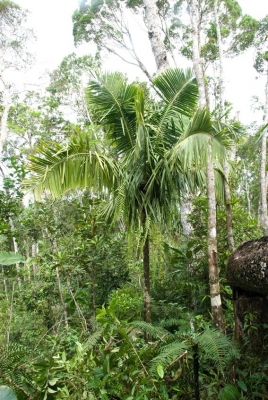Ravenea dransfieldii
Beentje
Arecaceae
Common Name:

Plants growing in native habitat
Photograph by: William J. Baker
Image credit to Palmweb

Plants growing in native habitat
Photograph by: William J. Baker
Image credit to Palmweb

Ankirindro, Makira Protected Area, Toamasina, Madagascar
Photograph by: William J. Baker
Image credit to Palmweb

Ripe fruits
Photograph by: William J. Baker
Image credit to Palmweb

Ankirindro, Makira Protected Area, Toamasina, Madagascar
Photograph by: William J. Baker
Image credit to Palmweb

Close-up of the fruits
Photograph by: William J. Baker
Image credit to Palmweb

Close-up of the inflorescence
Photograph by: John Dransfield
Image credit to Palmweb

Inflorescence
Photograph by: John Dransfield
Image credit to Palmweb

Ankirindro, Makira Protected Area, Toamasina, Madagascar
Photograph by: William J. Baker
Image credit to Palmweb
General Information
Ravenea dransfieldii is a single-stemmed, evergreen palm tree growing up to 7 metres tall. The unbranched stem can be 11 - 18cm in diameter, it is topped by a crown of 11 - 17 long, erect leaves[
314- Title
- Palm and Cycad Societies of Australia.
- Publication
-
- Author
-
- Website
- http://www.pacsoa.org.au/
- Publisher
-
- Year
- 0
- ISBN
-
- Description
- Contains at least a little information on the majority of palm and cycad species, plus a wealth of photographs. A first class website.
].
The leaves of this palm are are harvested from the wild and used locally to make high quality hats and also for thatching. The palm heart is also sometimes eaten.
The population size from the eight known sites is estimated to number about 200 mature individuals and the population is decreasing. The threats to this species include habitat loss through clearance for shifting agriculture and logging, and harvesting the species for its leaves. The plant is classified as 'Endangered' in the IUCN Red List of Threatened Species(2013)[
338- Title
- IUCN Red List of Threatened Species
- Publication
-
- Author
-
- Website
- http://www.iucnredlist.org/
- Publisher
-
- Year
- 0
- ISBN
-
- Description
- A list of plants under threat and facing possible extinction, usually with brief details of the threats and information on habitat.
].
Known Hazards
None known
Botanical References
Range
Africa - eastern Madagascar.
Habitat
Moist lowland forest, on slight to steep slopes or hill crests, at elevations from 100 - 700 metres[
338- Title
- IUCN Red List of Threatened Species
- Publication
-
- Author
-
- Website
- http://www.iucnredlist.org/
- Publisher
-
- Year
- 0
- ISBN
-
- Description
- A list of plants under threat and facing possible extinction, usually with brief details of the threats and information on habitat.
].
Properties
| Conservation Status | Endangered |
| Edibility Rating |      |
| Other Uses Rating |      |
| Habit | Evergreen Tree |
| Height | 6.00 m |
| Self-fertile | No |
| Cultivation Status | Wild |
Cultivation Details
Shady, sheltered, and moist[
314- Title
- Palm and Cycad Societies of Australia.
- Publication
-
- Author
-
- Website
- http://www.pacsoa.org.au/
- Publisher
-
- Year
- 0
- ISBN
-
- Description
- Contains at least a little information on the majority of palm and cycad species, plus a wealth of photographs. A first class website.
].
A dioecious species, both male and female forms need to be grown if fruit and seed are required[
455- Title
- Flore de Madagascar et des Comores
- Publication
-
- Author
- Humbert H.
- Website
- http://www.biodiversitylibrary.org/
- Publisher
- Museum National D'Histoire Naturelle; Paris
- Year
- 1946 - 1984
- ISBN
-
- Description
- Written in French, an excellent flora of the area though it has not been completed. Available for download from the Internet.
].
Edible Uses
The apical bud, often known as a 'palm heart', is eaten as a vegetable[
]. This species has a bitter palm heart, but it is eaten, although some believe it to be poisonous[
299- Title
- Protabase - Plant Resources of Tropical Africa.
- Publication
-
- Author
-
- Website
- http://www.prota.org
- Publisher
-
- Year
- 0
- ISBN
-
- Description
- An excellent on-line database with detailed information on over 3,200 species of useful plants of Africa.
,
]. Eating this bud leads to the death of the tree because it is unable to make side shoots[
K- Title
- Plants for a Future
- Author
- Ken Fern
- Description
- Notes from observations, tasting etc at Plants For A Future and on field trips.
].
Medicinal
None known
Other Uses
The leaf fibres are used in hat making[
299- Title
- Protabase - Plant Resources of Tropical Africa.
- Publication
-
- Author
-
- Website
- http://www.prota.org
- Publisher
-
- Year
- 0
- ISBN
-
- Description
- An excellent on-line database with detailed information on over 3,200 species of useful plants of Africa.
]. The young leaves are used for making high quality hats.
Leaves which are used for thatching and weaving[
338- Title
- IUCN Red List of Threatened Species
- Publication
-
- Author
-
- Website
- http://www.iucnredlist.org/
- Publisher
-
- Year
- 0
- ISBN
-
- Description
- A list of plants under threat and facing possible extinction, usually with brief details of the threats and information on habitat.
].
Propagation
Seed -
If you have any useful information about this plant, please leave a comment. Comments have to be approved before they are shown here.









 Useful Tropical Plants Database 2014 by
Ken Fern,
web interface by
Ajna Fern
with help from
Richard Morris.
Useful Tropical Plants Database 2014 by
Ken Fern,
web interface by
Ajna Fern
with help from
Richard Morris.